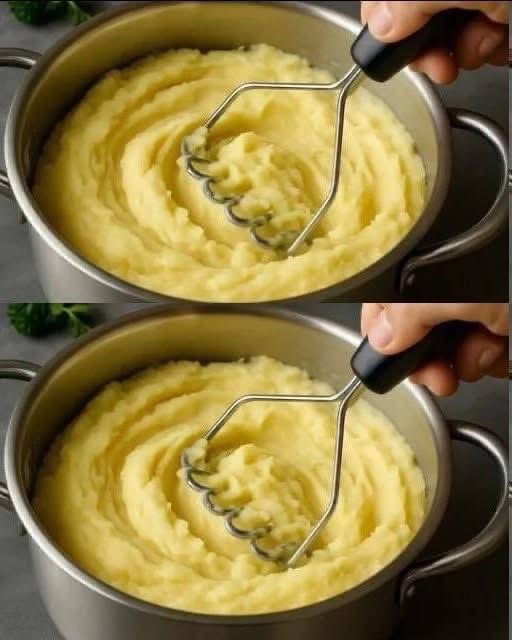Stop Adding Milk or Water to Your Mashed Potatoes
Introduction
Mashed potatoes are one of the most comforting and beloved side dishes worldwide. Fluffy, creamy, and rich, they’re often associated with warmth, family gatherings, and home-cooked goodness. Traditionally, recipes call for milk, cream, or even water to loosen the texture—but what if you didn’t need to add any liquid at all?
“Stop adding milk or water to your mashed potatoes” is more than just a kitchen hack—it’s a call to rediscover the natural creaminess and deep flavor of potatoes themselves. By adjusting technique instead of ingredients, you can create mashed potatoes that are richer, silkier, and more flavorful than ever.
Origin and Cultural Significance
The tradition of adding milk or water to mashed potatoes dates back centuries, when home cooks sought to stretch ingredients and make potatoes lighter. In many European and American kitchens, milk, cream, or butter became a staple addition to achieve a smoother texture and richer taste.
However, some culinary traditions—such as rustic French, Irish, and Eastern European cooking—emphasized the potato’s natural starches and buttery flavor, using minimal added liquid. Today, chefs and food enthusiasts are revisiting these traditional approaches to highlight the pure, earthy taste of the potato without dilution.
Mashed potatoes symbolize comfort and connection. By simplifying the recipe and focusing on quality and technique, you can celebrate both heritage and modern minimalism in your cooking.
Ingredients and Quantity
| Ingredient | Quantity | Purpose |
|---|---|---|
| Russet or Yukon Gold potatoes | 2 pounds (900 g) | The star ingredient—creamy and starchy |
| Unsalted butter | 4 tablespoons (½ stick) | Adds richness and silkiness |
| Salt | 1 teaspoon | Enhances flavor |
| Black pepper | ¼ teaspoon | Adds mild heat and depth |
| Olive oil (optional) | 1 tablespoon | For extra smoothness and flavor |
Optional Additions
- Roasted garlic – Adds sweetness and depth.
- Parmesan cheese – Introduces a nutty, savory kick.
- Chives or parsley – For a touch of freshness.
- Cream cheese or sour cream – Adds tang and creaminess without needing milk.
- Browned butter – Adds a nutty, caramelized richness.
Tips for Success
- Use the right potatoes. Russet or Yukon Gold varieties are ideal for smooth, creamy texture.
- Steam or bake instead of boiling.This keeps the potatoes dry and concentrated in flavor. Boiling can make them waterlogged.
- Mash while hot. Warm potatoes absorb butter better and yield a smoother mash.
- Add melted butter first. Butter coats starch molecules, giving a luscious texture.
- Use a potato ricer or masher. Avoid blenders or food processors, which can make potatoes gummy.
- Season as you mash. Gradually add salt and pepper to ensure even flavor distribution.
Instructions
- Prepare the potatoes: Peel and cut into even chunks.
- Cook: Steam or bake until tender (about 20 minutes if steaming, or 45 minutes baked at 400°F/200°C).
- Mash: Transfer hot potatoes to a bowl or pot.
- Add butter: Stir in melted butter until fully absorbed.
- Adjust texture: If needed, drizzle a small amount of olive oil—not milk or water—to achieve the desired consistency.
- Season: Add salt and pepper to taste.
- Serve immediately: Warm and creamy, with no added liquid needed.
Description
These no-milk mashed potatoes are dense, creamy, and intensely flavorful. By avoiding water or milk, you allow the potato’s natural starch and butter to shine, producing a velvety texture with a deep, earthy taste. The result is pure potato perfection—rich without heaviness, smooth without dilution.
Nutritional Information (per 1 cup serving)
| Nutrient | Amount |
|---|---|
| Calories | ~210 |
| Total Fat | 10 g |
| Saturated Fat | 6 g |
| Carbohydrates | 27 g |
| Protein | 3 g |
| Fiber | 3 g |
| Sodium | 300 mg |
| Sugars | 1 g |
Values may vary depending on type of potato and butter used.
Conclusion
Adding milk or water to mashed potatoes may seem traditional, but it can often dull the flavor and alter the perfect texture. By letting the potatoes and butter work together, you create a dish that’s naturally creamy, flavorful, and deeply satisfying. Sometimes, less truly is more.
Recommendation
For your next family meal or holiday feast, try making mashed potatoes without milk or water. Focus on good potatoes, gentle mashing, and proper seasoning. You’ll be surprised by how much flavor and texture you’ve been missing—and you might never go back to the old way again.
Embracing Healthful Indulgence
Cooking is about balance—between comfort and health, tradition and innovation. By reducing excess liquid and relying on quality ingredients, you craft a more wholesome version of a beloved comfort food. Each spoonful of these pure, butter-enriched mashed potatoes celebrates mindful indulgence: simple, honest, and utterly delicious.
